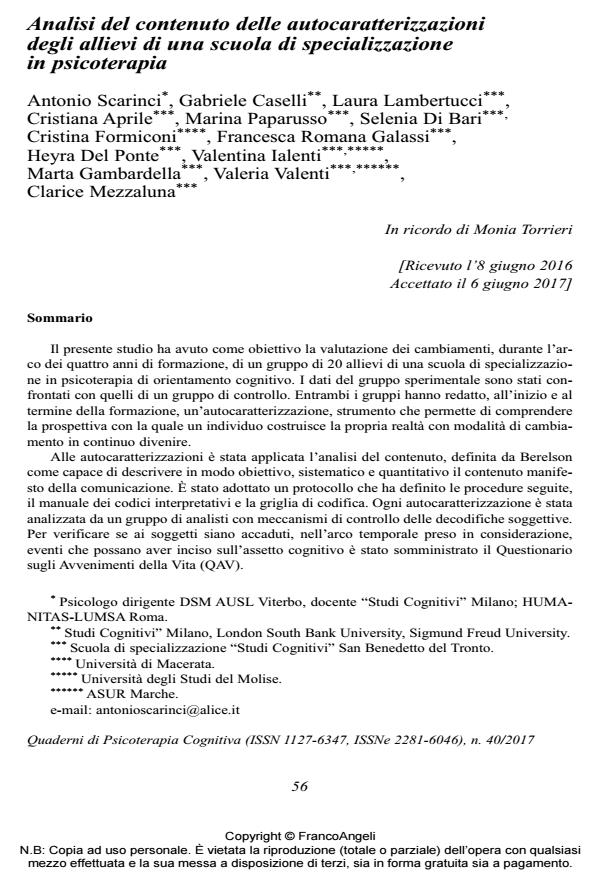Content analysis of self-characterizations of students from a postgraduate psychotherapy school
Journal title QUADERNI DI PSICOTERAPIA COGNITIVA
Author/s Antonio Scarinci, Gabriele Caselli, Laura Lambertucci, Cristiana Aprile, Marina Paparusso, Selenia Di Bari, Cristina Formiconi, Francesca Romana Galassi, Heyra Del Ponte, Valentina Ialenti, Marta Gambardella, Valeria Valenti, Clarice Mezzaluna
Publishing Year 2017 Issue 2017/40
Language Italian Pages 21 P. 56-76 File size 207 KB
DOI 10.3280/QPC2017-040004
DOI is like a bar code for intellectual property: to have more infomation
click here
Below, you can see the article first page
If you want to buy this article in PDF format, you can do it, following the instructions to buy download credits

FrancoAngeli is member of Publishers International Linking Association, Inc (PILA), a not-for-profit association which run the CrossRef service enabling links to and from online scholarly content.
The present study was aimed at evaluating changes, during the span of four-years training, in a group of twenty students from a postgraduate cognitive psychotherapy school. The data of the experimental group were compared with those of a control group. Both groups have drawn up, at the beginning and at the end of the training course, self-characterization, tool that allows us to understand the perspective from which an individual builds his/her own reality through constantly evolving change modes. Content analysis was applied to self-characterizations, as defined by Berelson as something able to describe the manifest content of communication in an objective, systematic and quantitative way. It was adopted a protocol that defines the procedures followed, the manual of interpretation codes and the encoding grid. Each self-characterization has been analyzed by a group of analysts with control mechanisms of the subjective decoding. Life Events Questionnaire (QAV) was admnistered to test whether subjects have undergone, in time period taken into consideration, events affecting their own cognitive set-up. The research results attest to significant variations between the experimental group and control group. The students, after four years of training, believe that others recognize in them a greater ability to explain behavior and attitudes of others, more self-reflective ability, a sense of satisfaction at the completion of their training and then taking a professional role.
Keywords: Self-characterization, training in psychotherapy, content analysis, cognitivebehavioural psychotherapy, accommodation.
Antonio Scarinci, Gabriele Caselli, Laura Lambertucci, Cristiana Aprile, Marina Paparusso, Selenia Di Bari, Cristina Formiconi, Francesca Romana Galassi, Heyra Del Ponte, Valentina Ialenti, Marta Gambardella, Valeria Valenti, Clarice Mezzaluna, Analisi del contenuto delle autocaratterizzazioni degli allievi di una scuola di specializzazione in psicoterapia in "QUADERNI DI PSICOTERAPIA COGNITIVA" 40/2017, pp 56-76, DOI: 10.3280/QPC2017-040004